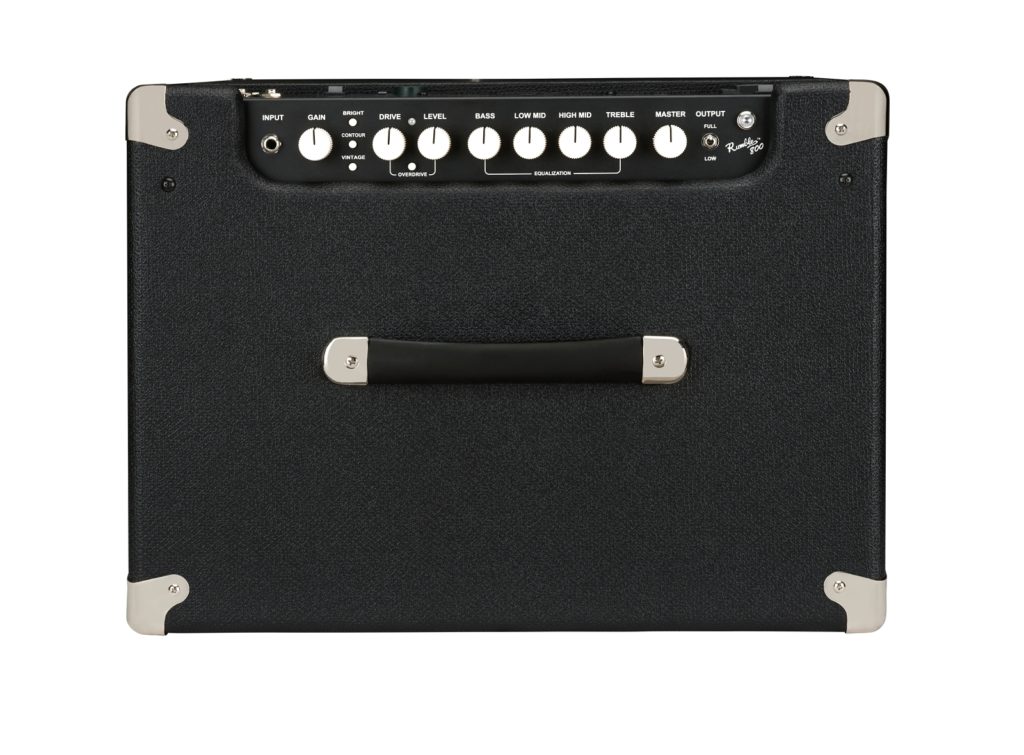Fender Music Australia | Price: $1,399
Fender bass amps have been a mainstay on stages since the ‘50s when Fender literally invented the electric bass. Bass itself has evolved greatly over that time and so have the sonic demands of players, and Fender has kept an eye on those changing trends with all sorts of innovative amps incorporating modern features and flexible tone options. The Rumble 800 is a relatively affordable amplifier which aims to place this research and development into a modern, player-friendly form factor that maintains that classic Fender aesthetic. Let’s have a closer look.
Read more gear reviews here.
The Rumble 800 is an 800-watt (you read that right) Class D combo – a head version is also available – with two custom-designed 10” Eminence Neodymium speakers and a high-frequency horn in a black vinyl-covered enclosure with a silver grille cloth. As a solid state amp it’s incredibly light and portable, coming in at 13.15kg. I’ve carried bags of dog food to the car that were heavier than that. Many of us would be able to tramp upstairs with the Rumble 800’s carry handle in one hand, a pedalboard bag in the other, and our bass in a gig bag on our back for a single-trip load in.
The preamp has three voicings – bright, which naturally adds a bit of treble brilliance to the tone; contour, which offers a focused mid scoop for slap-and-pop and more hi-fi modern sounds, and vintage, which is voiced to replicate a classic tube amp sound. The preamp is fed by an input gain control which is separate to the selectable overdrive circuit, governed by drive and level controls. Think of it as a transparent overdrive pedal built right into the amp. There’s a four-band EQ with bass and treble controls sandwiching low-mid and high-mid knobs. The master volume control is accompanied by a full/low output switch for bringing the overall volume down for those more intimate gigs or cranking up to full awesome power for bigger ones.
Around the back you’ll find 1/4” send and return jacks for the effects loop, 1/8” aux in and phones jacks, a footswitch jack (and the footswitch is included, which is much appreciated because a lot of amp companies make you buy the switch separately), and an XLR line out with ground-lift button and a pre/post button for DI purposes. There’s also an on/off switch for the high frequency horn, which you can basically treat as a high-frequency tone switch in its own right, and an external speaker jack switchable between 400W eight-ohm minimum and 500W four-ohm minimum to unleash the full devastating power of those 800 watts. There are various Rumble extension cabinets available for just that purpose, with speaker configurations of 2×10”, 4×10”, and 1×15”.
I tested the Rumble 800 with a variety of basses including an Ibanez Soundgear five-string with active electronics, another Ibanez with passive electronics, and a Squier Bass VI with Seymour Duncan Hot For Jaguar pickups.
Make no mistake: this amp can get loud. And those Neodymium speakers are extremely efficient so it’s usable volume, not loud-but-too-woolly volume. The three voicing switches are crucial to your tone-shaping experience here because the Rumble 800 practically turns into a different amp depending on how it’s configured. It can be a punchy, clear, super clean bass machine or a filthy rock monster according to the demands of the gig or the song. The vintage mode adds a slight compression and warm harmonic overtones that are further enhanced by the overdrive circuit for big growly rock tones, but metal players might find themselves appreciating the scooped option underneath that overdrive for almost Peter Steele-like distorted bass tones. Having said that, it would have been nice to have a mix control for the overdrive circuit. The level control is handy for balancing between clean and dirty volumes but a lot of players like to mix clean and dirty simultaneously and that’s something this amp isn’t designed for. So if that sounds like you, you’ll have to use a stomp box or processor for your dirty/clean combination.
The Bass VI was especially friendly to the vintage mode with a little bit of grit from the overdrive circuit, allowing the instrument’s guitar-like frequencies to stand out even while emphasising the more bassy aspects. I added a little chorus and delay from Fender Hammertone pedals and was in Robert Smith territory pretty easily. The active five-string really seemed to like the contour switch, which I expected as this bass seems to be at its best with scooped mids for more of a ‘felt rather than heard’ vibe. You know the sound – the kind that fills up the low end but doesn’t draw a lot of attention away from the harmony instruments with a lot of growl and attack in competing frequencies. And the passive five-string seemed to be the perfect blank slate for letting the amp really show off its various capabilities. The voicing switches are key to this of course but so is the pair of midrange controls which allow you to really nail exactly how your bass is going to sit within a mix, and to subtly increase or decrease emphasis on particular aspects of your tone.
This is a lot of bass amp packed into a lightweight enclosure with loads of power and plenty of tonal flexibility. Having said that, if the whopping 800 watts of grunt is too much for you, the same preamp is available in smaller combos of 40, 100, 200, and 500 watts, and there are stripped back feature sets available in 25-watt and 15-watt combos in the same livery as well for those who want to get their Rumble on but don’t need the full power or tone options. Whichever one you choose though, your tone is in some very capable hands.

Head to Fender for more information. For local enquiries, reach out to Fender Music Australia.







